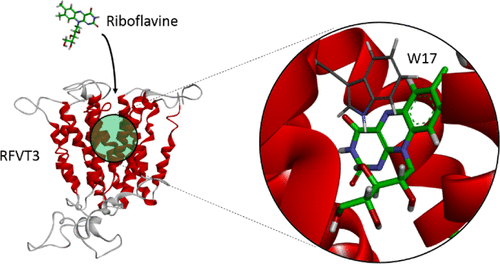当前位置:
X-MOL 学术
›
J. Chem. Inf. Model.
›
论文详情
Our official English website, www.x-mol.net, welcomes your feedback! (Note: you will need to create a separate account there.)
In Silico Identification of a Key Residue for Substrate Recognition of the Riboflavin Membrane Transporter RFVT3.
Journal of Chemical Information and Modeling ( IF 5.6 ) Pub Date : 2020-01-10 , DOI: 10.1021/acs.jcim.9b01020 Sébastien Dilly 1 , Mélanie Garnier 1 , Marion Solé 1 , Rémi Bailly 1 , Nada Taib 1 , Isabelle Bestel 1
Journal of Chemical Information and Modeling ( IF 5.6 ) Pub Date : 2020-01-10 , DOI: 10.1021/acs.jcim.9b01020 Sébastien Dilly 1 , Mélanie Garnier 1 , Marion Solé 1 , Rémi Bailly 1 , Nada Taib 1 , Isabelle Bestel 1
Affiliation

|
Because of its specific physicochemical properties (fluorescence, photosensitizing, and redox reactions), vitamin B2, also called riboflavin (RF), has been generating a lot of interest in the fields of nanotechnology and bioengineering in the last decade. RF, by targeting its riboflavin transporters (RFVTs) overexpressed in some cancers, is particularly used to functionalize nanovectors for anticancer drug delivery. From a physiopathological point of view, an RF deficiency has been implicated in various pathologies, including mendelian diseases. RF deficiency is mainly due to natural variants of its RFVTs that make them inactive and therefore prevent RF transport. The lack of structural data about RFVT is a major drawback for a better understanding of the role of the mutations in the molecular mechanism of these transporters. In this context, this work was aimed at investigating the 3D structure of RFVT3 and its interactions with RF. For this purpose, we used an in silico procedure including protein threading, docking, and molecular dynamics. Our results propose that the natural variant W17R, known to be responsible for the Brown-Vialetto-Van Laere syndrome, prevents the recognition of RF by RFVT3 and thus blocks its transport. This in silico procedure could be used for elucidating the impact of pathogenic mutations of other proteins. Moreover, the identification of RF binding sites will be useful for the design of RF-functionalized nanovectors.
中文翻译:

在计算机上鉴定核黄素膜转运蛋白RFVT3的底物识别关键残基。
由于其特定的物理化学特性(荧光,光敏和氧化还原反应),在过去的十年中,维生素B2(也称为核黄素(RF))在纳米技术和生物工程领域引起了很多兴趣。通过靶向在某些癌症中过度表达的核黄素转运蛋白(RFVT),RF被特别用于功能化纳米载体以用于抗癌药物的递送。从生理病理学的观点来看,RF缺乏症已经牵涉到包括孟德尔病在内的各种病理学中。RF缺乏主要是由于其RFVT的自然变体,使它们不活动并因此阻止了RF传输。缺少有关RFVT的结构数据是更好地了解突变在这些转运蛋白的分子机制中的作用的主要缺点。在这种情况下,这项工作旨在研究RFVT3的3D结构及其与RF的相互作用。为此,我们使用了计算机程序,包括蛋白质穿线,对接和分子动力学。我们的研究结果表明,已知引起布朗-维亚莱托-范莱尔综合征的天然变异W17R阻止了RFVT3对RF的识别,从而阻止了其运输。此计算机程序可用于阐明其他蛋白质的致病性突变的影响。而且,RF结合位点的鉴定对于RF功能化的纳米载体的设计将是有用的。我们的研究结果表明,已知引起布朗-维亚莱托-范莱尔综合征的天然变异W17R阻止了RFVT3对RF的识别,从而阻止了其运输。此计算机程序可用于阐明其他蛋白质的致病性突变的影响。而且,RF结合位点的鉴定对于RF功能化的纳米载体的设计将是有用的。我们的研究结果表明,已知引起布朗-维亚莱托-凡莱尔综合征的自然变异W17R阻止了RFVT3对RF的识别,从而阻止了其运输。此计算机程序可用于阐明其他蛋白质的致病性突变的影响。而且,RF结合位点的鉴定对于RF功能化的纳米载体的设计将是有用的。
更新日期:2020-01-10
中文翻译:

在计算机上鉴定核黄素膜转运蛋白RFVT3的底物识别关键残基。
由于其特定的物理化学特性(荧光,光敏和氧化还原反应),在过去的十年中,维生素B2(也称为核黄素(RF))在纳米技术和生物工程领域引起了很多兴趣。通过靶向在某些癌症中过度表达的核黄素转运蛋白(RFVT),RF被特别用于功能化纳米载体以用于抗癌药物的递送。从生理病理学的观点来看,RF缺乏症已经牵涉到包括孟德尔病在内的各种病理学中。RF缺乏主要是由于其RFVT的自然变体,使它们不活动并因此阻止了RF传输。缺少有关RFVT的结构数据是更好地了解突变在这些转运蛋白的分子机制中的作用的主要缺点。在这种情况下,这项工作旨在研究RFVT3的3D结构及其与RF的相互作用。为此,我们使用了计算机程序,包括蛋白质穿线,对接和分子动力学。我们的研究结果表明,已知引起布朗-维亚莱托-范莱尔综合征的天然变异W17R阻止了RFVT3对RF的识别,从而阻止了其运输。此计算机程序可用于阐明其他蛋白质的致病性突变的影响。而且,RF结合位点的鉴定对于RF功能化的纳米载体的设计将是有用的。我们的研究结果表明,已知引起布朗-维亚莱托-范莱尔综合征的天然变异W17R阻止了RFVT3对RF的识别,从而阻止了其运输。此计算机程序可用于阐明其他蛋白质的致病性突变的影响。而且,RF结合位点的鉴定对于RF功能化的纳米载体的设计将是有用的。我们的研究结果表明,已知引起布朗-维亚莱托-凡莱尔综合征的自然变异W17R阻止了RFVT3对RF的识别,从而阻止了其运输。此计算机程序可用于阐明其他蛋白质的致病性突变的影响。而且,RF结合位点的鉴定对于RF功能化的纳米载体的设计将是有用的。



























 京公网安备 11010802027423号
京公网安备 11010802027423号